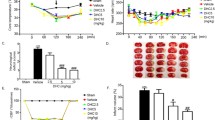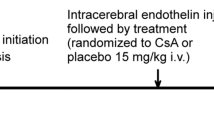Abstract
The pathophysiology of brain ischemia is characterized by a complex sequence of events, which include biochemical, hemodynamic and electrophysiological processes. Decreases in cerebral blood flow (CBF) below a critical threshold result in energy failure, tissue acidosis, disturbed ion homeostasis, with cellular Na+ and Ca++ influx and K+ efflux, membrane depolarization, and cytotoxic edema. There is a massive release of excitatory amino acid neurotransmitters (glutamate and aspartate) which triggers further membrane depolarization and an additional accumulation of intracellular Ca++. This accumulation of free cytosolic intracellular Ca++ appears to play a key role in the progression of events towards irreversible neuronal damage, in that it leads to an activation of a series of neurotoxic processes including lipid peroxidation, free radical generation, activation of proteolytic enzymes and pathological gene activation. The formation of vasogenic tissue edema is another important consequence of brain ischemia, which frequently complicates the clinical situation.
Access this chapter
Tax calculation will be finalised at checkout
Purchases are for personal use only
Preview
Unable to display preview. Download preview PDF.
Similar content being viewed by others
References
C.N. Oliver, P. Stark-Reed, E.R. Stadtman, G.L. Liu, J.M. Carney and R.A. Floyd, Ischemia/reperfusion induced oxidative damage to proteins in gerbil brain, Proc. Natl. Acad. Sci.U.S.A. 87:5144 (1990).
Betz, A.L., Identification of hypoxanthine transport and xanthine oxidase activity in brain capillaries, J. Neurochem. 44:574 (1985).
D. Martz, G. Rayos, G.P. Schielke and A.L. Betz, Allopurinol and dimethylthiourea reduce brain infarction following middle cerebral artery occlusion in rats, Stroke 20:488, 1989.
T. Spector, Oxypurinol as an inhibitor of xanthine oxidase-catalyzed production of Superoxide radical, Biochem. Pharmacol. 37:349 (1988).
M.H. O’Regan, J.W. Phillis and G.A. Walter, The effects of the xanthine oxidase inhibitors, allopurinol and oxypurinol on the pattern of purine release from hypoxic rat cerebral cortex, Neurochem. Int. 14:91 (1989).
J.W. Phillis, G.A. Walter and R.E. Simpson, Brain adenosine and transmitter amino acid release from the ischemic rat cerebral cortex: Effects of adenosine deaminase inhibitor deoxycoformycin, J. Neurochem. 56:644 (1991).
S.C. Gerhardt and C.A. Boast, Motor activity changes following cerebral ischemia in gerbils are correlated with the degree of neuronal degeneration in the hippocampus, Behav. Neurosci. 102:301 (1988).
J.W. Phillis, Oxypurinol attenuates ischemia-induced hippocampal damage in the gerbil, Brain Res. Bull. 23:467 (1989).
J.W. Phillis and C. Clough-Helfman, Oxypurinol, but not deoxycoformycin, administered post-ischemia, protects against CA1 hippocampal damage in the gerbil, Int.J. Purine Pyrimid. Res. 1:31 (1990).
Y. Lin and J.W. Phillis, Oxypurinol reduces focal ischemic brain injury in the rat, Neurosci. Lett. 126:187 (1991).
T.H. Liu, J.S. Beckman, B.A. Freeman, E.L. Hogan and C.Y. Hsu, Polyethylene glycol-conjugated Superoxide dismutase and catalase reduce ischemic brain injury, Am.J. Physiol. 256:H589 (1989).
Author information
Authors and Affiliations
Editor information
Editors and Affiliations
Rights and permissions
Copyright information
© 1991 Springer Science+Business Media New York
About this chapter
Cite this chapter
Phillis, J.W., Lin, Y. (1991). Oxypurinol Reduces Ischemic Brain Injury in the Gerbil and Rat. In: Harkness, R.A., Elion, G.B., Zöllner, N. (eds) Purine and Pyrimidine Metabolism in Man VII. Advances in Experimental Medicine and Biology, vol 309A. Springer, Boston, MA. https://doi.org/10.1007/978-1-4899-2638-8_77
Download citation
DOI: https://doi.org/10.1007/978-1-4899-2638-8_77
Publisher Name: Springer, Boston, MA
Print ISBN: 978-1-4899-2640-1
Online ISBN: 978-1-4899-2638-8
eBook Packages: Springer Book Archive




